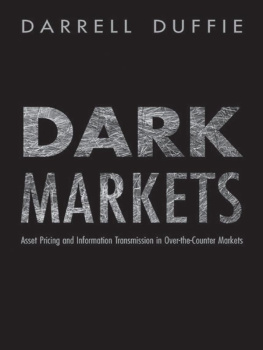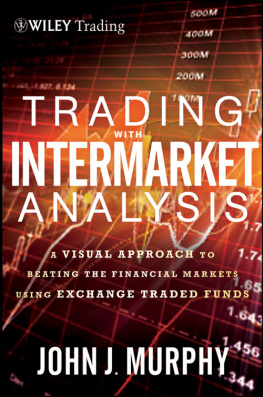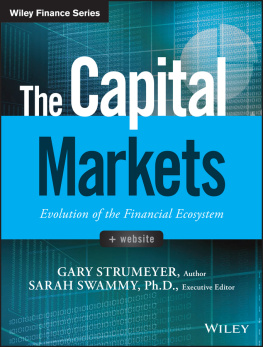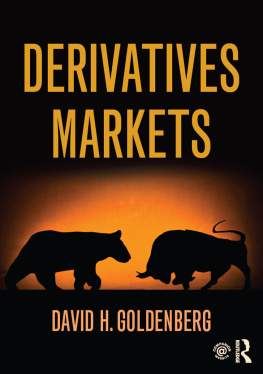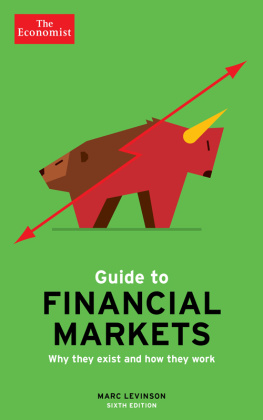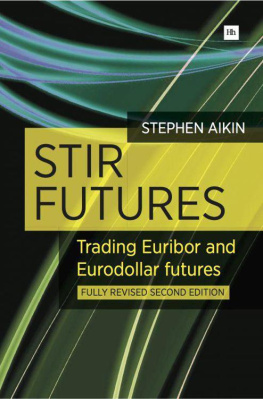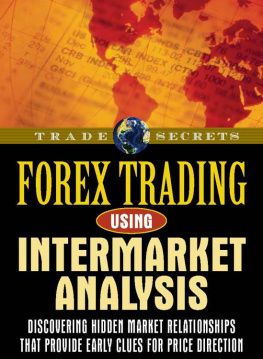DARK MARKETS
PRINCETON LECTURES IN FINANCE
Yacine At-Sahalia, Series Editor
The Princeton Lectures in Finance, published by arrangement with the Bendheim Center for Finance of Princeton University, are based on annual lectures offered at Princeton University. Each year, the Bendheim Center invites a leading figure in the field of finance to deliver a set of lectures on a topic of major significance to researchers and professionals around the world.
Stephen A. ROSS, Neoclassical Finance
William F. Sharpe, Investors and Markets: Portfolio Choices, Asset Prices, and Investment Advice
Darrell Duffie, Dark Markets: Asset Pricing and InformationTransmission in Over-the-Counter Markets
Dark Markets
ASSET PRICING AND INFORMATION TRANSMISSION
IN OVER-THE-COUNTER MARKETS
Darrell Duffie
This work is published by arrangement with the
Bendheim Center for Finance of Princeton University
PRINCETON UNIVERSITY PRESS
PRINCETON AND OXFORD
Copyright 2012 by Princeton University Press
Published by Princeton University Press, 41 William Street, Princeton, New Jersey 08540
In the United Kingdom: Princeton University Press, 6 Oxford Street, Woodstock, Oxfordshire OX20 1TW
press.princeton.edu
All Rights Reserved
Library of Congress Cataloging-in-Publication Data
Duffie, Darrell.
Dark markets : asset pricing and information transmission in over-the-counter markets / Darrell Duffie.
p. cm.(Princeton lectures in finance)
Includes index.
ISBN 978-0-691-13896-1 (hardcover : alk. paper) 1. Over-the-counter markets. 2. Capital assets pricing model. I. Title.
HG4521.D87 2012
332.643dc23
2011034092
British Library Cataloging-in-Publication Data is available
This book has been composed in Times
Printed on acid-free paper.
Printed in the United States of America
1 3 5 7 9 10 8 6 4 2
To Kingston
Contents
Tables
Figures
Preface
This research monograph addresses the behavior of over-the-counter (OTC) markets. Rather than trading through a centralized mechanism such as an auction, specialist, or broadly accessible limit-order book, participants in an OTC market negotiate terms privately with other market participants, often pairwise. OTC investors, other than major dealers, may be largely unaware of prices that are currently available elsewhere in the market, or of recent transactions prices. In this sense, OTC markets are relatively opaque; investors are somewhat in the dark about the most attractive available terms and about who might offer them. We will focus attention on how prices, asset allocations, and information transmission in OTC markets are influenced by opaqueness.
The financial crisis of 20072009 brought significant concerns and regulatory action regarding the role of OTC markets, particularly from the viewpoint of financial instability. OTC markets for derivatives, collateralized debt obligations, and repurchase agreements played particularly important roles in the crisis and in subsequent legislation. The modeling of OTC markets, however, is still undeveloped in comparison to the available research on central market mechanisms.
My objective is to provide a brief introduction to OTC markets, including some of the key conceptual issues and modeling techniques. I hope to serve the interests of relevant sets of academics, investors, and regulators. Those reading beyond are assumed to have a graduate-level knowledge of probability theory.
, from joint work with Adam Ashcraft, is a case example: the OTC market for overnight loans of federal funds, the cash of the U.S. banking system. Adam and I are grateful for support and data from the Federal Reserve Bank of New York and for conversations with Jamie McAndrews, Craig Furfine, and anonymous federal funds traders. We also benefited from comments by Andrew Metrick, Jeremy Stein, Ken French, Larry Harris, Owen Lamont, John Taylor, and Randy Westerfield. The views expressed in this chapter are not necessarily those of the Federal Reserve Bank of New York or the Federal Reserve System.
, is used to calculate the cross-sectional distribution of types of matches across the population. This is then extended to treat multiperiod search in both discrete-time and continuous-time frameworks. The optimal search intensity of a given agent, given the cross-sectional distribution of types in the population, is formulated and characterized with Bellmans principle. The chapter ends with a brief formulation of equilibrium search and a short review of the early history of the literature.
, from work by Duffie, Grleanu, and Pedersen (2005, 2007), presents a simple introduction to asset pricing in OTC markets with symmetric information. Investors search for opportunities to trade and bargain with counterparties. Each of two negotiating investors is aware that a failure to complete a trade could lead to a potentially costly delay in order to search for a different counterparty. In equilibrium, the two investors agree to trade whenever there are potential gains from trade. The equilibrium asset price that they negotiate reflects the degree of search frictions, among other aspects of the market.
, based mainly on Duffie and Manso (2007), Duffie, Giroux, and Manso (2010), and Duffie, Malamud, and Manso (2010b), focuses on the percolation of information of common interest through an OTC market, as agents encounter each other over time and reveal information to each other, some of which they may have received earlier from other agents. The chapter includes an explicit solution of the evolution over time of the cross-sectional distribution in the population of the posterior probability assignments of the various agents.
reviews the basics of counting processes with an intensity, such as Poisson processes.
The original impetus for this manuscript is the Princeton Lectures in Finance, given at Princeton University in late 2007. The title, Dark Markets, was the result of a conversation with Yacine At-Sahalia, to whom I am also grateful for acting as my host for the Princeton lectures. Updated and enhanced versions of these lectures have been prepared for the 2008 Nash Lecture, hosted by Steven Shreve, at Carnegie-Mellon University; for a doctoral course at the University of Lausanne in the summer of 2009; for the Fields Institute Distinguished Lecture Series, April 2010, hosted in Toronto by Matheus Grasselli; for the Distinguished Lecture Series at Humboldt University hosted in Berlin by Ulrich Horst in June 2010; for the 2010 Tinbergen Lectures at the Duisenberg Institute, hosted in Amsterdam by Andr Lucas and Ton Vorst; and for the Minerva Foundation Lectures in the Mathematics Department at Columbia University in March 2011, hosted by Ioannis Karatzas and Johannes Ruf. I am grateful for many discussions with students and faculty during my visits to present these lecture series.
I am extremely grateful for research assistance from Sergey Lobanov, Felipe Veras, and Haoxiang Zhu. I have also had useful conversations with Pierre Collin-Dufresne, Alessio Farhadi, Kristoffer Laursen, Jason Granet, and Pierre-Olivier Weill. My largest debt is to my collaborators on this topic: Adam Ashcraft, Nicolae Grleanu, Gaston Giroux, Semyon Malamud, Gustavo Manso, Lasse Heje Pedersen, Bruno Strulovici, Yeneng Sun, and Haoxiang Zhu. I have indicated throughout where I have drawn from our joint work. I am especially grateful for extensive comments provided on a prior version of the manuscript by Lasse Heje Pedersen, Felipe Veras, and two anonymous reviewers. I am also thankful to Janie Chan and Seth Ditchik of Princeton University Press for helpful editorial advice.
Darrell Duffie
Stanford University
May 2011
DARK MARKETS
Next page
